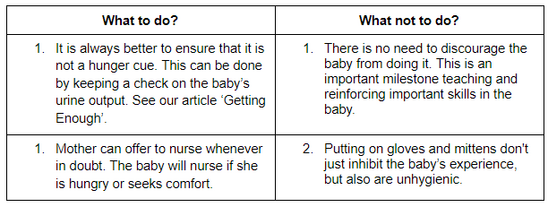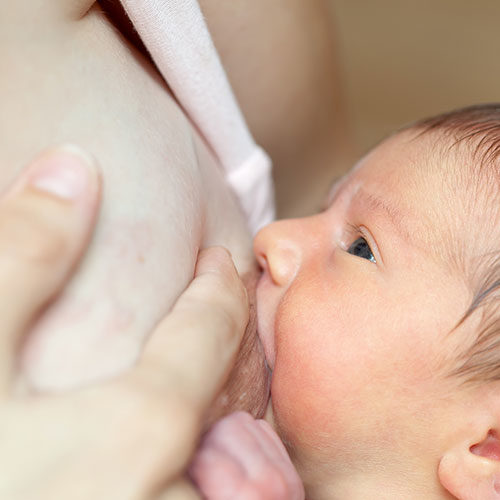What is Hand to Mouth behavior in babies?
Hand to mouth is the act of a baby bringing her hands to her mouth. This could then turn into the baby sucking on her fingers/thumb or fist. This behaviour can indicate different things depending on the age of the baby.
1. Newborn to less than 2 months old
From the time babies are in the mother’s womb, they are known to suck on their thumb/fingers and fist. Ultrasounds show babies bringing their hands to their faces before swallowing amniotic fluid. This is actually a process in the feeding pattern, which explains why babies bring their hands to their mouths when they are hungry. It is one of the early hunger cues. It is observed among newborns that even after the mother picks the baby up to nurse, while she is trying to latch the baby, the baby puts her hand into the mouth as if impatient for the mother’s breast. Sometimes the mother gets confused or disheartened by perceiving it as breast refusal. But all the baby is trying to do is to indicate that she is hungry.
2. Babies around 2.5 to 3 months old and older
As the babies grow up a little, they are eager to explore the world around them. They do this through their mouth. The most effective and receptive sensory organ is their mouth at this stage. And thus, they explore the world by bringing it to their mouth. The most accessible things of all are their limbs. The baby starts actively bringing hands to mouth. It becomes a developmental milestone at this point, and may no longer be a hunger cue.
Meaning of Hand to Mouth Behaviour :

Importance of Hand to Mouth Behaviour:
- It is one of the earliest developmental milestones which indicates that the bay is growing well.
- It helps form an early body image (body awareness and mapping) in the baby’s brain.
- It is one of the first steps in establishing voluntary muscle control.
- Repeated movements help in the development of fine motor skills. It also contributes to strengthening the muscles used for fine finger movements for feeding, reaching and crawling.
- Bringing hands to mouth also helps in calming the infants. As a self-soothing strategy, it helps develop self-regulation.
Dos and Don’ts for when the baby displays this behaviour:

Can Hand to Mouth become a bad habit?
Many families are concerned that hand to the mouth could potentially turn into a bad habit, if left uncorrected. This is not true. All babies develop at their own pace and have their own style of learning. Some babies suck more than others. Once the babies are sitting up well and using their fingers/hands to play/manipulate toys, this behaviour starts reducing naturally.
However, many babies continue to use it for self-soothing. Some babies may occasionally resort to it when they are stressed or anxious. Usually, this all stops naturally by the baby is 3-5 years old. Thumb sucking may need to be addressed if it continues beyond the age of 5 years.
References :
http://www.psychology.emory.edu/cognition/rochat/lab/Hand-MouthCoordinationintheNewbornMorphologyDeterminantsandEarlyDevelopmentofaBasicArt.pdf
https://www.mayoclinic.org/healthy-lifestyle/childrens-health/in-depth/thumb-sucking/art-20047038

Wish to speak with a member of our team who is a certified lactation professional and also an experienced breastfeeding mother, click on this link.
Medical Advice Disclaimer
THIS WEBSITE DOES NOT PROVIDE MEDICAL ADVICE.
The information, including but not limited to, text, graphics, images and other material contained on this website are for informational purposes only. No material on this site is intended to be a substitute for professional medical advice, diagnosis or treatment. Always seek the advice of your physician or other qualified health care provider with any questions you may have regarding a medical condition or treatment before undertaking a new health care regimen, and never disregard professional medical advice or delay in seeking it because of something you have read on this website.
Disclaimer
We understand and acknowledge that parents and babies can be of various genders on a spectrum of LGBTQI+. Families come in diverse flavours. However, in our articles, for the sake of simplicity and convenience, we will be referring to the breastfeeding parent as the mother and using the female pronouns- ‘she’ and ‘her’ for babies. Babies can be nourished and nurtured in different ways and while we have used the terms breastfeeding and nursing, we recognize that parents can opt to chest feed or finger feed.
We don’t have conflicts of interest and declare, and we are compliant with the WHO code of marketing of breastmilk substitutes and the IMS act.
In case you find any information on this website that needs to be updated, please write to us at info@bsim.org.in






